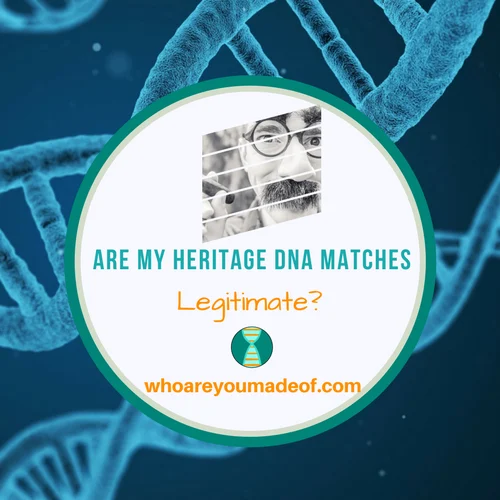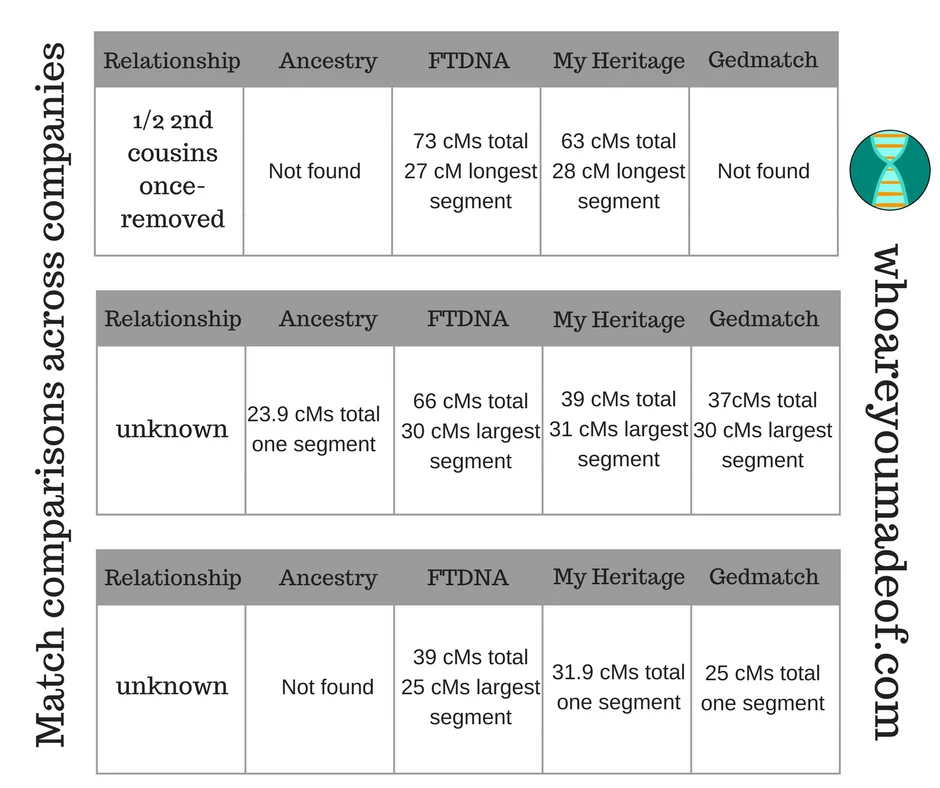In this post, you will learn whether MyHeritage DNA matches are legitimate, and the basic ways that you can determine how your match might be related to you.

Did you just get your My Heritage DNA results back? Or did you do a free autosomal DNA transfer from another testing company to My Heritage?
When you look at the people on your My Heritage DNA match list, do you wonder if they are truly related to you? This is a common feeling when viewing any list of genetic relatives because most of the people on the list are unfamiliar to us.
Are the My Heritage DNA matches real?
The short answer is yes. The DNA matches that you find on My Heritage DNA are valid, and you will be able to learn from them and their posted family trees just like you can learn from your DNA matches on other sites.
The longer answer requires a little bit of an explanation. The more DNA you share with your match on MyHeritage, the higher the probability that the person is a true genealogical relative, meaning that you share a common ancestor in your family tree.
The testing companies determine that someone is a DNA relative based on the number and size of matching DNA segments shared between you and your potential match. The longer and more numerous the shared segments, the closer the relationship.
If you share just one small segment with someone, say a segment less than about 10 centimorgans (cM )in length, there is a chance that the segment is just coincidentally identical. For segments smaller than 5 cM, there is a high chance that the segment is not identical by descent (meaning it is not identical because you share a common ancestor).
I have a few examples of DNA matches for my father's kit, which is on Ancestry DNA, FTDNA, MyHeritage, and Gedmatch. In the image below, you can see the amount of DNA (measured in centimorgans) that was detected at MyHeritage DNA compared to the other companies.

As you can see, MyHeritage DNA's algorithm detects very similar amounts of DNA as compared to Ancestry, FTDNA, and Gedmatch. The conclusion that I have arrived to is that the DNA matches that show up on MyHeritage are trustworthy.
How can I tell how I am related to my MyHeritage DNA matches?
The MyHeritage DNA website interface makes it really easy to see all of the information that is available about your DNA matches, and you can use the information provided to see clues about your potential relationship.
Below, I will give you some ideas about which bits of information will be the most useful to you when you are first getting started going through your match list:
Check out the total amount of shared DNA
In almost all situations, the more DNA you share with someone, the closer the relationship. The total amount of centimorgans that you share with your DNA match will give you an idea of the type of relationship that you might share, from close family to distant cousin.
How long is the longest segment of shared DNA?
Mothers and fathers both pass down very long segments DNA to their children, but with the passing of each generation, those segments get broken up. This is why you only share very small segments with distant cousins that you both inherited from an ancestor long, long ago.
The end result of this? The longer the segment, the closer the most recent common ancestor. In addition, single, small shared segments generally indicate a distant cousin relationship.
Do they have a tree on the site that they manage?
MyHeritage makes it very easy to spot whether your DNA match has a tree, and how extensive it is. Towards the bottom of the box where the DNA match's name and details about the match appear, you will see a little tree icon with information describing how many people are in the tree and who manages it.
The image below shows just where to look on your DNA match list. The person who did the test shares only 8.7 centimorgans with this match, which means that he would probably have to look very far back in his family tree to find out who they share as a common ancestor.

In order to view the names in your match's tree, you should click the purple "Review DNA Match" button and scroll down a bit until you see the pedigree chart for your match. If you spot a common ancestor or a common surname, you might be on the right track towards determining your relationship.
It is important to note that you might not be able to see family tree information for every match. Many people have chosen to not display their family tree information to DNA matches by changing their privacy settings.
Do you have any shared DNA matches?
This is a great feature of the MyHeritage DNA website, and you should definitely take advantage of it. Just click on "Review DNA Match", and scroll down a little bit to see the shared matches.
On the left, you will see how the match is related to you (estimated) and on the right, you'll see how the match is related to your match (also estimated). You can click through to these matches and examine their trees, as well as your shared DNA, to figure out how all of you might be related.
Which ethnicities do you share?
If you don't find any clues in the family tree or the shared DNA, you might have luck narrowing down a trace ethnicity that you both share, or don't share, in order to determine which line of the family you are both descended from.
This is tricky and a bit unreliable, but it's worth a look if you don't spot any other useful information.
If you have a premium account, you can contact your DNA matches.
Conclusion
I hope that this post has helped you get a better understanding of your MyHeritage DNA matches. You should now be able to get a good idea about how they are related to you, and use that information to build your family tree a little bit further out.
If you have any questions about anything that I have mentioned here, or have a specific DNA match that you have questions about, please feel free to leave a comment here with the details about how much DNA you share, and how many segments you share.
Thanks for stopping by!

